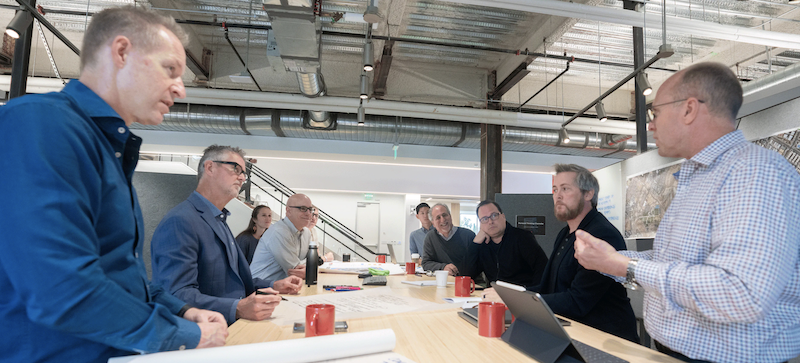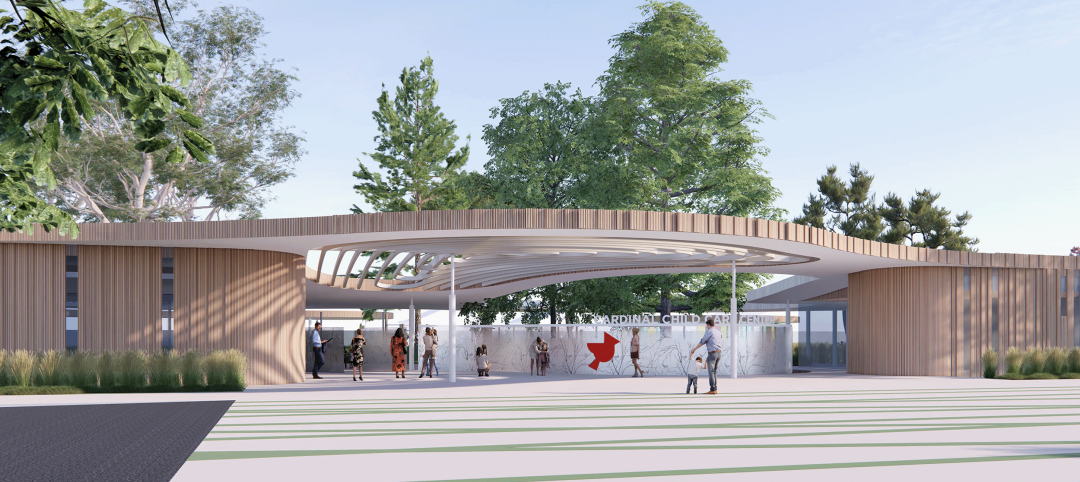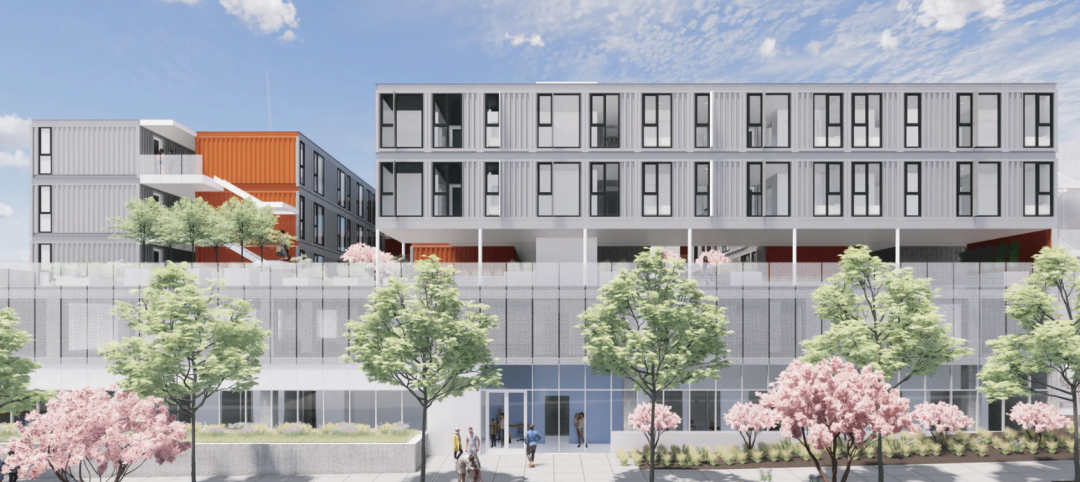For the past year, LPA designers have been engaging with executives from the esports industry to explore concepts for the next generation of esports facilities. Part of Catalyst’s Forward Thinking series, the exercise was focused on developing new ideas to connect the industry in meaningful ways with a larger community and delivering a model for infrastructure to address fast-growing demand.
Early on, the discussion moved beyond the simple model of an esports arena. The real opportunity lies in tapping the energy and enthusiasm of the global fan base beyond the spectator arena, the experts agree. The audience for esports is expected to grow from 167 million in 2018 to 267 million in 2022, which would make it a rival to the National Football League, according to Newzoo, an industry research firm. Gamers and their fans are loyal and passionate, representing a wide variety of demographics. They travel long distances for tournaments and events, which often last six hours or more.
 Executives from Cake Studios and De Tune joined the esports discussion held at LPA’s Irvine studio.
Executives from Cake Studios and De Tune joined the esports discussion held at LPA’s Irvine studio.
“Ultimately, we create shared experiences,” says Stephen Tisdale, LPA client and creative director for De Tune, the global broadcast media and event production agency. “It’s about people coming together.”
As esports become more mainstream, the challenge for the industry is to break down the walls between esports and the non-gaming community and leverage the available supporting opportunities. The world is still generally separated between esports enthusiasts and those that know almost nothing about esports. Events are typically staged in general-purpose arenas or impersonal broadcast facilities. “The infrastructure to support esports doesn’t exist,” says Michael Thuney, executive producer of De Tune.
Thuney was part of a design charrette hosted in LPA’s Irvine studio that included Tisdale and Mannix, president and creative director of Cake Studios, LLC, a sports-focused branding, design and animation firm. LPA designers from different sectors participated, including Sport + Rec, Civic and Interiors. The LPA team has worked with the game industry on different projects, including corporate headquarters for game companies Blizzard and High Moon, and is familiar with the opportunity to engage different demographics. But they wanted to learn more about the anatomy of esports events, the needs of the industry and the mechanics of an esports facility.
“We were able to really talk about what makes a successful event,” says LPA Senior Project Designer Jeff Schaub, who led the LPA design effort. “There is a six-hour window of opportunity where we can capture people pre-event and post-event.”
The discussion often returned to the opportunities that exist around the games, looking for ways to turn the infrastructure into a facility that attracts an audience day and night. Many of the esports arenas coming online are simply plopped onto an existing parking lot, without the necessary support spaces. “We looked at everything that happens on the outside of the arena, in a broader sense,” Schaub said. “We wanted to know how esports could support a multi-use facility when there isn’t an event happening.”
After months of probing, the discussions always returned to some variation of the same question: “How can these facilities make communities better?” asked LPA Design Director Rick D’Amato.
The final design focuses on reimagining an aging, under-utilized shopping mall, recognizing the economic realities of the shifting retail landscape. The design takes a holistic approach, addressing the different needs and goals of developers, esports companies and the neighborhood. The newest technology is applied to rebrand the aging center. The “bones” of the mall are preserved, but esports serve as a catalyst for a new type of community center.
“There is an opportunity to take older malls and leverage that existing infrastructure to develop a new community asset,” Schaub says.
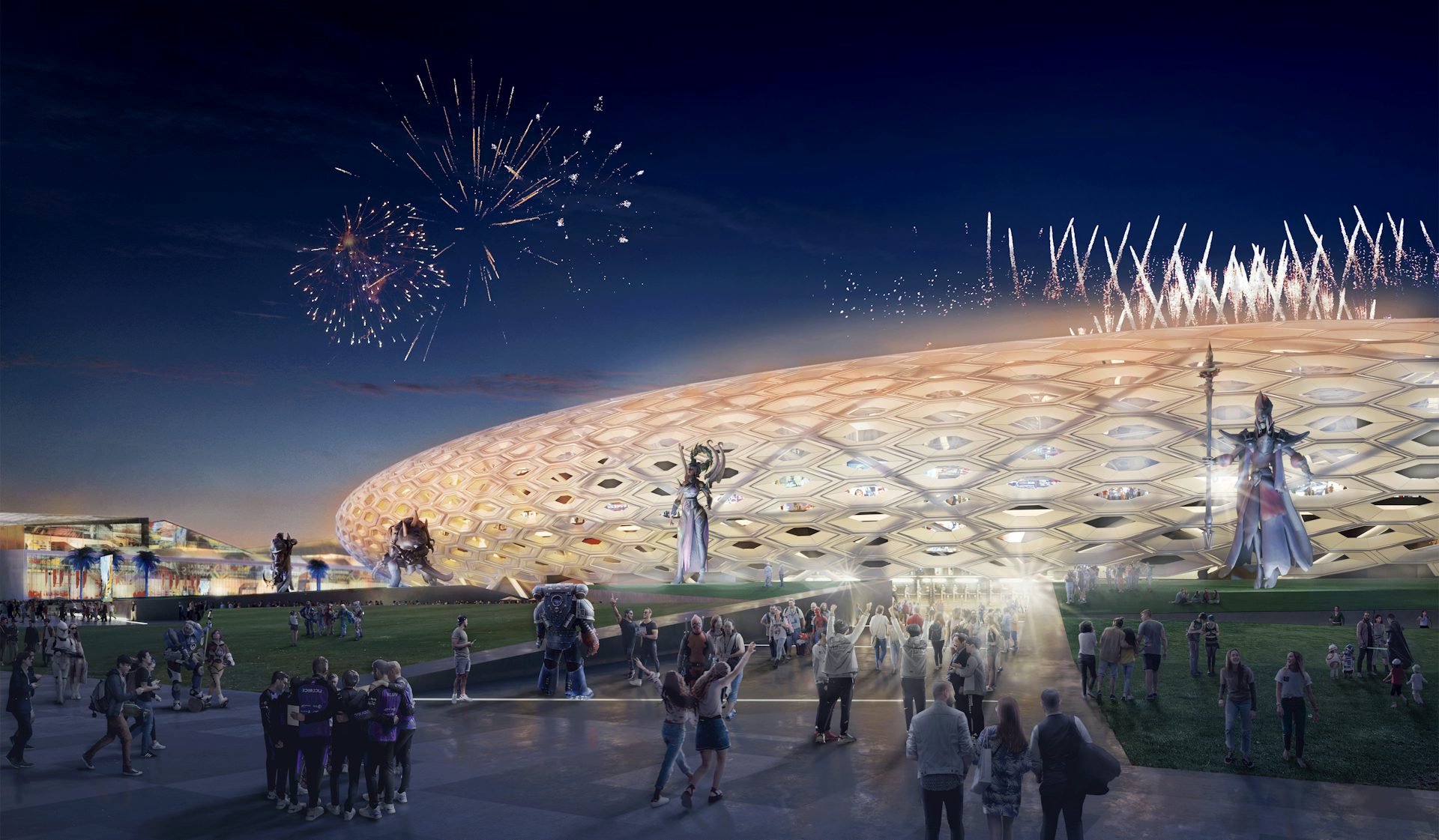 The audience for esports is expected to grow from 167 million in 2018 to 267 million in 2022, according to Newzoo, an industry research firm.
The audience for esports is expected to grow from 167 million in 2018 to 267 million in 2022, according to Newzoo, an industry research firm.
A primary multi-sport esports arena is the centerpiece of a modernized center, which is designed around the interests of the esports demographics. The arena would be designed to host the sport’s big events, with a dynamic-aperture parametric skin that would allow people to see the activities inside while creating a surface for graphics and animation. Community spaces curl around the arena, providing healthy environments for local gatherings and an open-air festival setting during large arena events.
One big-box site in the old mall has been replaced with a secondary LAN (local area network) fusion arena, which would host smaller community matches, training functions and live tournaments. The LAN arena is designed as a flexible space, a modern version of the community rec center, creating the vibe of a skate park for esports gamers.
The heart of the center is repurposed to add new retail spaces and opportunities for brands and sponsors to connect with their audience. Third-level spaces are created for viewing and special game areas. Throughout the venue, there are areas celebrating games and the sports stars.
“This provides a pathway for an esports venue to generate market penetration very fast with the existing infrastructure,” Schaub says. “By looking at the big picture of what an esports venue can be, beyond the arena, it can be much more sustainable for the community.”
The design brings esports out of the dark corridors and creates open, lively spaces around the gaming arenas. There are spaces for players to train and warm up in healthy, open-air environments. The facility raises the bar for the sport, offers a second life for malls and provides opportunities for the esports industry and its sponsors to engage fans in new ways.
Building Something New on the Old
The proposed design uses the infrastructure of the aging shopping mall as the foundation for the new esports community complex. A big box site is removed to provide space for the arena and open the facility to a new audience.
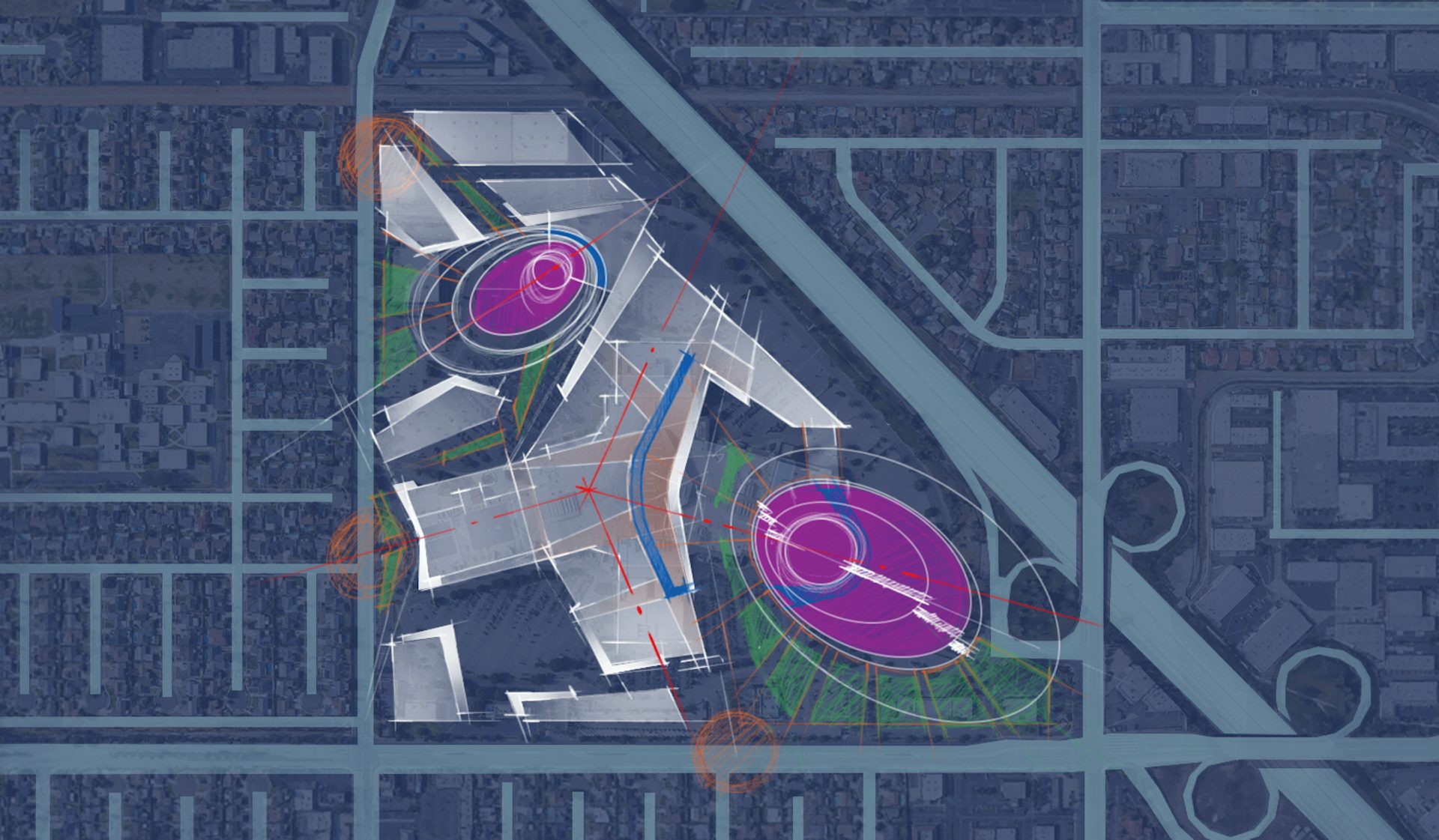 An initial site sketch tested early ideas developed in the charrette, including contrasting freeway and pedestrian faces, the arena objects, connective green spaces and circulation systems.
An initial site sketch tested early ideas developed in the charrette, including contrasting freeway and pedestrian faces, the arena objects, connective green spaces and circulation systems.
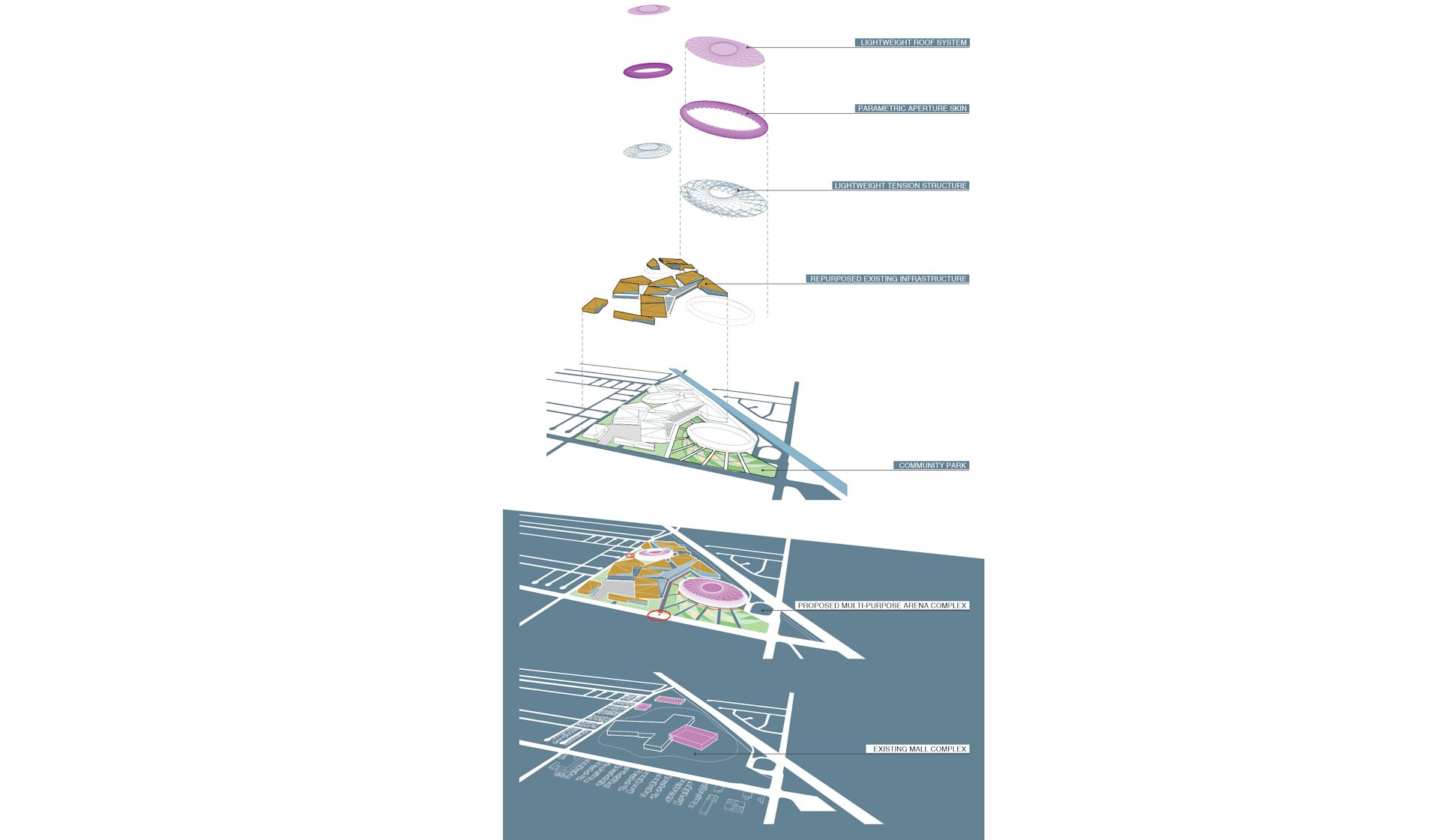
EXISTING MALL COMPLEX: The big box retail store and out buildings would be demolished to provide room for the twin arenas.
MULTI-PURPOSE ARENA COMPLEX: Creates the primary circulation systems and mixed-use activities supporting the complex, including merchandising, cosplay, digital art galleries, education, music, transportation hub, restaurants and coffee.
COMMUNITY PARK: Engages the surrounding community, reworks the transportation flow and replaces a sea of parking. The space radiates around the arena to become a destination and a pedestrian funnel toward the interior street and main entrances.
REPURPOSED EXISTING INFRASTRUCTURE: The design enlivens the mall relic in a new aesthetic, supporting a new metaphor — the Polygon, the DNA of gaming.
ARENA STRUCTURE: The dynamic aperture ETFE parametric skin allows for transitions in visual transparency, environmental conditions and video projection.
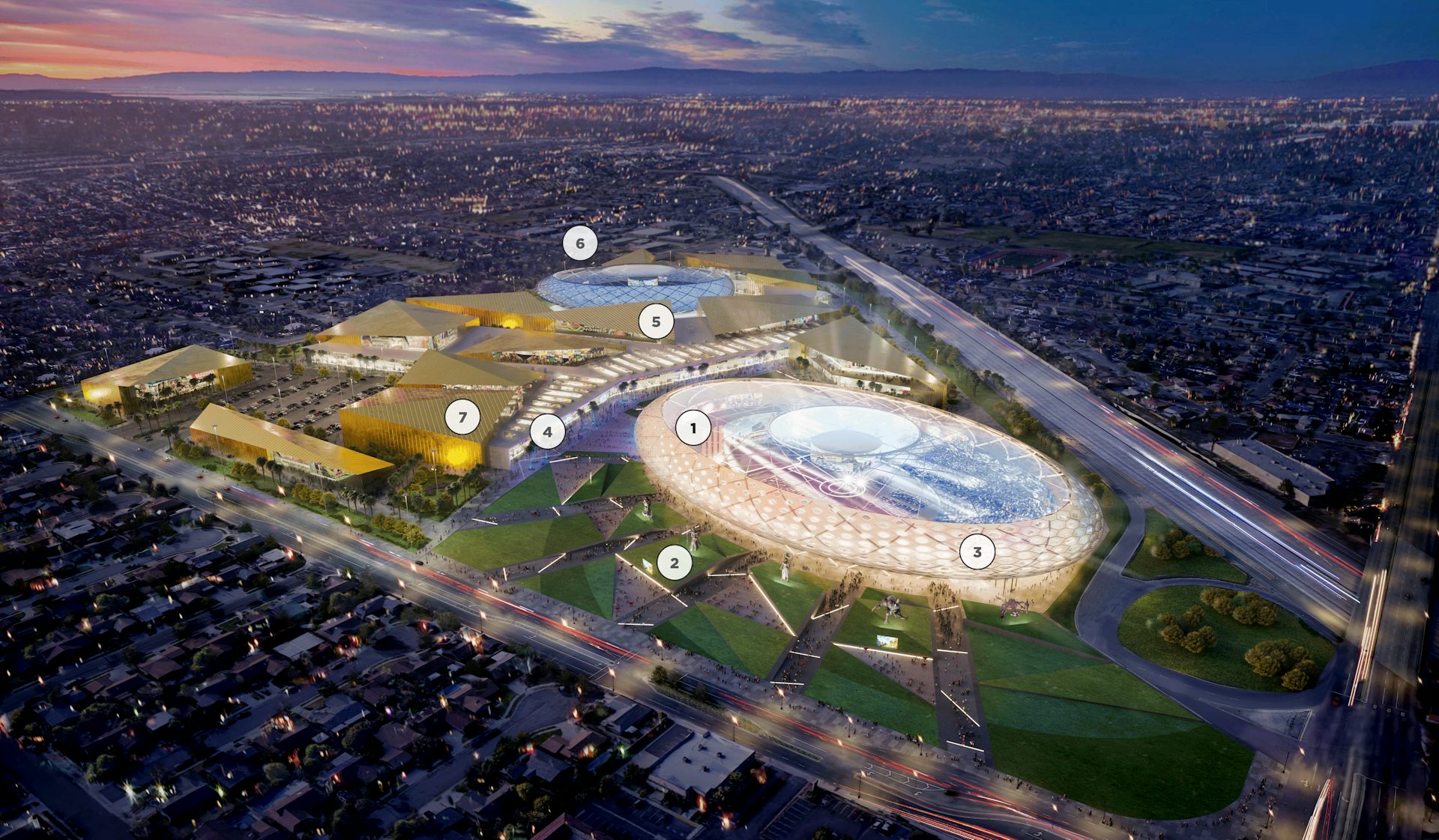
A Mixed-Use eSports Community Center
The design uses the bones of an aging shopping mall as the framework for a multi-purpose facility centered around esports. The new model celebrates the popularity of esports and creates new facilities for gamers, while developing a day/night retail and entertainment destination.
1: THE PRIMARY MULTI-PURPOSE PERFORMANCE VENUE is a catalyst for the surrounding development, providing a worldwide destination for major esports events, as well as a multi-purpose community asset.
2: A COMMUNITY-ENGAGING GREEN is a series of radiating green spaces to engage the neighborhood and provide park-like amenities, in addition to spaces for festivals and events.
3: THE DYNAMIC APERTURE PARAMETRIC SKIN of the arena creates a transparent, shifting surface to highlight event activities inside the arena and showcase video and graphic projections.
4: COMPLEMENTARY MIXED USE spaces emphasize the synergies between esports and the entertainment industries, with an array of flexible merchandising, dining, art galleries, education and music areas.
5: REPURPOSED EXISTING MALL INFRASTRUCTURE takes advantage of opportunities to energize under-utilized spaces, including the creation of new third-level areas for events and dining.
6: A SECONDARY LEAGUE/LAN FUSION AREA is a smaller, community-focused venue for training, league tournaments and local “LAN Party” events.
7: RE-FACETED MALL SKIN reworks the existing mall facades to reskin the facility in angular geometries alluding to polygons, which are part of the DNA of gaming.
More from Author
LPA | Aug 26, 2024
Windows in K-12 classrooms provide opportunities, not distractions
On a knee-jerk level, a window seems like a built-in distraction, guaranteed to promote wandering minds in any classroom or workspace. Yet, a steady stream of studies has found the opposite to be true.
LPA | May 13, 2024
S.M.A.R.T. campus combines 3 schools on one site
From the start of the design process for Santa Clara Unified School District’s new preK-12 campus, discussions moved beyond brick-and-mortar to focus on envisioning the future of education in Silicon Valley.
LPA | Mar 28, 2024
Workplace campus design philosophy: People are the new amenity
Nick Arambarri, AIA, LEED AP BD+C, NCARB, Director of Commercial, LPA, underscores the value of providing rich, human-focused environments for the return-to-office workforce.
LPA | Feb 8, 2024
LPA President Dan Heinfeld announced retirement
LPA Design Studios announced the upcoming retirement of longtime president Dan Heinfeld, who led the firm’s growth from a small, commercial development-focused architecture studio into a nation-leading integrated design practice setting new standards for performance and design excellence.
LPA | Mar 2, 2023
The next steps for a sustainable, decarbonized future
For building owners and developers, the push to net zero energy and carbon neutrality is no longer an academic discussion.
LPA | Dec 20, 2022
Designing an inspiring, net zero early childhood learning center
LPA's design for a new learning center in San Bernardino provides a model for a facility that prepares children for learning and supports the community.
LPA | Aug 22, 2022
Less bad is no longer good enough
As we enter the next phase of our fight against climate change, I am cautiously optimistic about our sustainable future and the design industry’s ability to affect what the American Institute of Architects (AIA) calls the biggest challenge of our generation.
LPA | Aug 9, 2022
Designing healthy learning environments
Studies confirm healthy environments can improve learning outcomes and student success.
LPA | Jul 6, 2022
The power of contextual housing development
Creating urban villages and vibrant communities starts with a better understanding of place, writes LPA's Matthew Porreca.
LPA | Mar 21, 2022
Finding the ROI for biophilic design
It takes more than big windows and a few plants to create an effective biophilic design.

